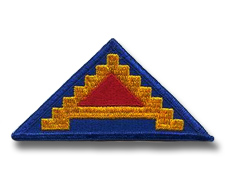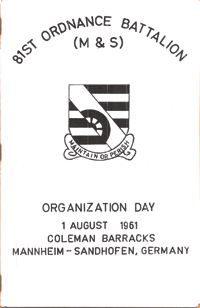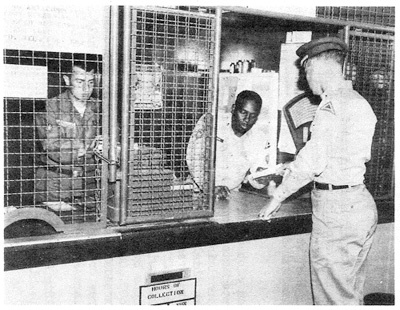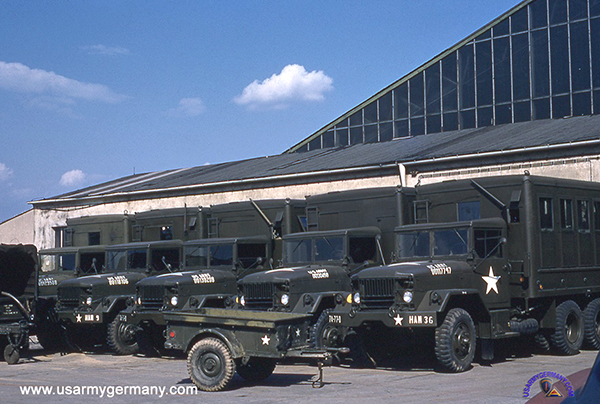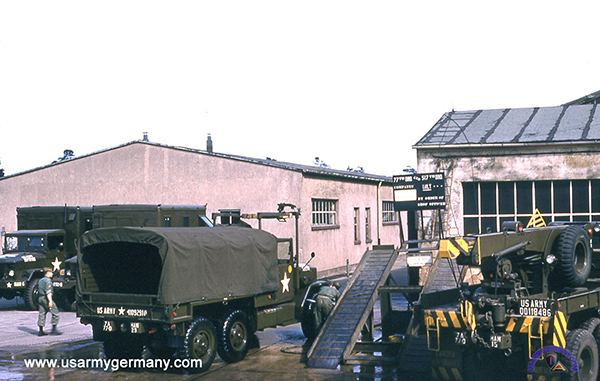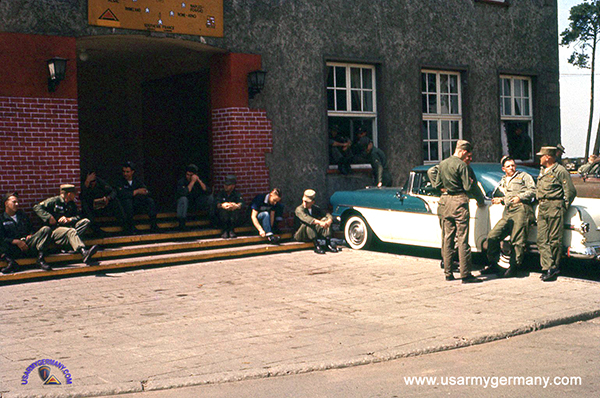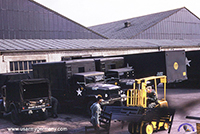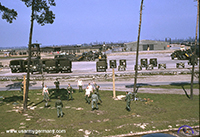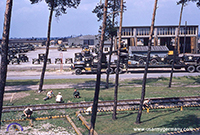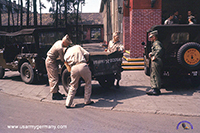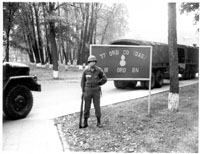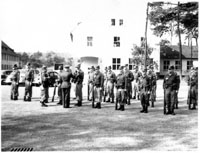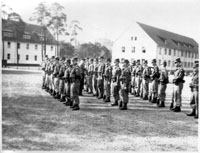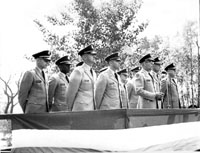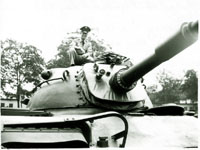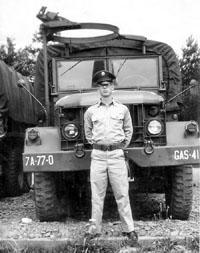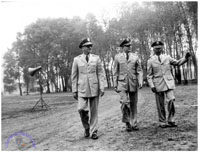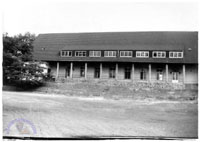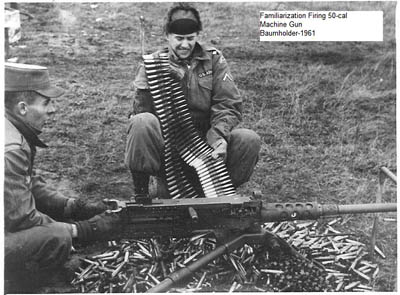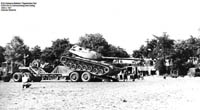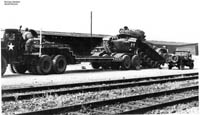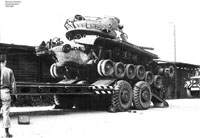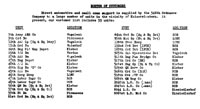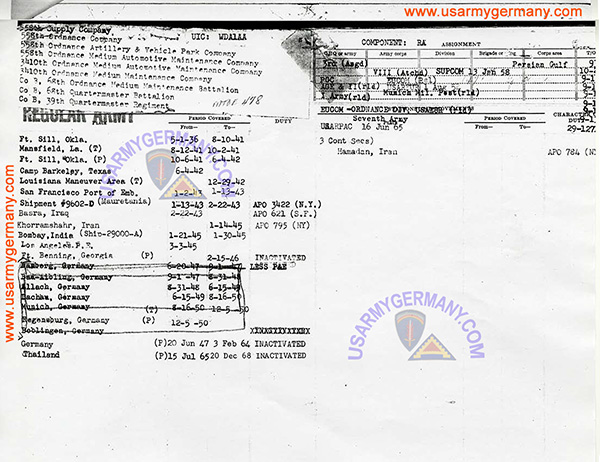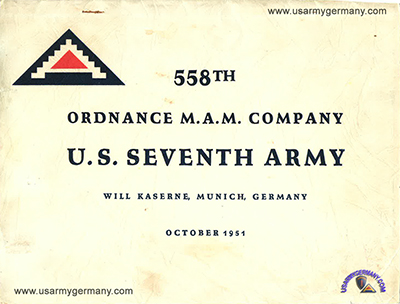| If you do
NOT see the Table of Contents frame to the left of this page, then
Click here to open 'USArmyGermany' frameset |
|||||||||||||||||||||||||||
|
81st
Ordnance Battalion (M&S) |
|||||||||||||||||||||||||||
|
|
|||||||||||||||||||||||||||
|
|||||||||||||||||||||||||||
|
|
|||||||||||||||||||||||||||
| 81st Ordnance Battalion | |||||||||||||||||||||||||||
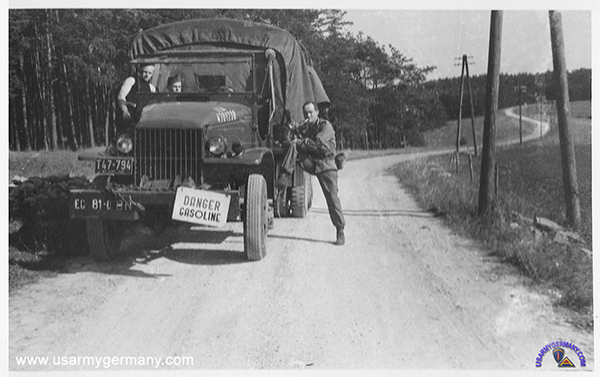 A deuce-and-a-half of the 81st Ord Bn parked on a rural road near Esslingen, c. 1949 |
|||||||||||||||||||||||||||
| 1949 - 1965 | |||||||||||||||||||||||||||
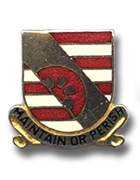 81st Ordnance Bn DUI
81st Ordnance Bn DUI |
|||||||||||||||||||||||||||
| (Source: Various notes taken during research by the webmaster) | |||||||||||||||||||||||||||
| The 81st
Ordnance Battalion was activated on 25 June 1949 in Böblingen.
The Bn headquarters was soon moved to Esslingen, Germany. On 15 Dec 1952, the battalion moved to Mainz, Germany. Sometime after that, the battalion was relocated to Braconne, France, site of an COMZ Ordnance Depot. The battalion remained there until 7 Dec 1954. On that day, the battalion (less personnel and equipment) was reassigned to the 7th Army and moved to Kaiserslautern where it was attached to the 51st Ord Gp. In Kaiserslautern, the battalion was reformed drawing personnel and equipment from other ordnance units of the 51st Group. The new 81st Ord Bn became operational on 14 Dec 1954. |
|||||||||||||||||||||||||||
|
ORGANIZATION
(30 June 1958):
|
|||||||||||||||||||||||||||
|
|||||||||||||||||||||||||||
| [1] STATION LIST, June 1959 | |||||||||||||||||||||||||||
| As part of the COSTAR reorganization in 1965, the 81st Ord Bn was reorganized and redesignated as the 81st Maintenance Bn. | |||||||||||||||||||||||||||
| If you have more
information on the history or organization of the 81st Ord Bn, please
contact me |
|||||||||||||||||||||||||||
| (Source: 81st Ord Bn (M&S), Organization Day, 1 Aug 1961; via Everette Dillard) | |||||||||||||||||||||||||||
I served in the 77th Ord Co, March 1960 until February 1962. I have some history about the 81st which I received in 1961, a booklet they gave out when we were having the organization day.
|
|||||||||||||||||||||||||||
ORGANIZATION (1961): |
|||||||||||||||||||||||||||
|
|||||||||||||||||||||||||||
|
|||||||||||||||||||||||||||
| On 15 April 1958, the 546th Ordnance Company, the 48th Ordnance Company, the 152nd Ordnance Detachment and the 168th Ordnance Detachment were relieved of attachment to the 81st Ordnance Battalion. The battalion moved from Rhein Ordnance Barracks, Kaiserslautern to Coleman Barracks, Mannheim/Sandhofen its present location, on 15 October 1959. The 167th Ordnance Detachment was attached to the battalion on 1 December 1960, the 28th Army Postal Unit on 21 February 1961, the Seventh United States Army Advanced Weapons Guided Missile Company, Gonsenheim on 15 March 1961, and the 367th Ordnance Detachment on 1 April 1961. The Seventh United States Army Advanced Weapons Guided Missile Company, Gonsenheim and the 367th Ordnance Detachment were inactivated on 24 June 1961. The 579th Ordnance Company was activated and attached to the 81st Ordnance Battalion on that same day. The present mission of the 81st Ordnance Battalion is: The 81st Ordnance Battalion is commanded by Lieutenant Colonel W.F. Konopka, Ordnance Corps. 77th Ordnance Company (General Automotive Support) The 77th Ordnance Company remained on the inactive list until 20 July 1950 when it was called out of retirement and activated at Will Kaserne, Munich, Germany. Initial personnel for the company were furnished by the 7720th EUCOM Replacement Depot, the 19th Ordnance Battalion and the 7849th Ordnance Stock Control Detachment. The company was under operational control of Chief, Ordnance Division, USAREUR, and attached, for administration only, to the Karlsfeld Ordnance Depot Company. The company was assigned to Seventh Army on 24 November 1950, and attached to the 80th Ordnance Battalion (Maintenance & Supply) on 7 December 1950. From the date of activation until 15 January 1951, the company was engaged in stocking and loading depot vans and heavy unit trucks. During this period, some unit personnel were assigned duties in platoons while others were sent to various USAREUR Service Schools. On 15 January 1951, the 77th moved to Index Kaserne, Esslingen, Germany. The company was assigned the mission of providing Class II and Class IV Ordnance General Supplies, except vehicles and towed artillery to the maintenance companies of the 80th Ordnance Battalion. The 77th continued to serve at Index Kaserne until June 1954 when it moved to Funker Kaaerne, also at Esslingen. The 77th was redesignated the 77th Ordnance Company (Field Supply) am 20 November 1954, and on 1 November 1955 was relieved of attachment to the 80th Ordnance Battalion and attached to the 51st Ordnance Group. The company was further attached to the 19th Ordnance Battalion (Supply). On 12 March 1956, the 77th was relieved of attachment to the 19th Ordnance Battalion and was then attached to the 81st Ordnance Battalion (Maintenance & Supply). The unitts designation was changed from "Field Supply" to "Heavy Automotive Maintenance" on 15 March 1956, and on 23 May 1956 the company moved from Funker Kaserne in Esslingen to Rhein Ordnance Barracks in Kaiserslautern. The unit was transferred from Rhein Ordnance Barracks in Kaiserslautern to Coleman Barracks, Manneim-Sandhofen, its present location, on 21 June 1957. The designation of the 77th Ordnance Company as "General Automotive Support" was made on 20 September 1959. On 19 January 1961,, the 77th departed Coleman Barracks and made a motor march to the Seventh Army Training Center (Grafenwoehr-Vilseck-Hohenfels) where it participated in Exercise WINTERSHIEID II, Seventh Army's annual winter maneuver for 1961. During Exercise WINTERSHIELD II, the 77th provided wheel vehicle maintenance services on a 24 hour basis at Grafenwoehr and Hohenfels for all neutral vehicles engaged in the exercise. Neutrals included umpires, fire marker teams, VIP's, medical teams and signal teams,, and the total number of vehicles supported exceeded fifteen hundred. The exercise was concluded on 10 February 1961. The 77th Ordnance Company and its personnel returned to Coleman Barracks with plaudits from senior commanders and supported elements for outstanding performance in the field. The present mission of the 77th Ordnance Company is: The 77th Ordnance Company is commanded by Captain Cecil A. Sumpter, Jr., Ordnance Corps. 517th Ordnance Company (General Support) Having been alerted for overseas movement shortly after the completion of Exercise SOUTHERN PINE, the 517th Ordnance Company moved to Camp Kilmer, New Jersey in October 1951 for staging and shipment to Germany. In November 1951, the 517th sailed from New York aboard the USNS GENERAL McRAE bound for Bremerhaven, Germany. Upon arrival in Germany, the 517th Ordnance Company was assigned to Seventh Army with duty station in Buedingen. In June 1953, the 517th was redesignated the 517th Ordnance Company (Heavy Maintenance). Since arriving in Germany, the 517th has been stationed at Buedingen, Kaiserslautern, and Mannheim-Sandhofen. On 20 June 1957, the company moved from Rhein Ordnance Barracks, Kaiserslautern to Coleman Barracks, Mannheim-Sandhofen, its present location. The unit was redesignated "General Support" in September 1959. (See Ron Ouellete's email for corrections) The present mission of the 517th Ordnance Company is: The 517th Ordnance Company is commanded by Captain Homer W. Jean, Jr., Ordnance Corps. 533rd Ordnance Company (Collection and Classification) On 11 April 1956, the 533rd Ordnance Reclamation and Classification Company was redesignated the 533rd Ordnance Company (Recovery & Classification). The company was activated at Kaiserslautern, Germany on 17 April 1956 and attached to the 81st Ordnance Battalion. On 16 June 1957, the company moved to its present location at Coleman Barracks, Mannheim-Sandhofen, Germany. The 533rd Ordnance Company was redesignated "Collection & Classification" on 31 August 1960. The present mission of the 533rd Ordnance Company is: The 533rd Ordnance Company is commanded by Captain Wesley L. Dunham, Ordnance Corps. 579th Ordnance Company (Guided Missile General Support) The 579th Ordnance Company is the newest ordnance unit in the entire United States Army, and is the latest addition to the 81st Ordnance Battalion family. Constituted and activated at Wiesbaden, Germany on 24 June 1961, the 579th is the first Guided Missile General Support Ordnance Unit to be employed in an overseas theatre. The formation of this company is only the latest in a long series of actions taken to provide Seventh Army Missile units with the best ordnance support available in the entire army. The original personnel for the 579th Ordnance Company were drawn chiefly from the Seventh United States Army Advance Weapons Guided Missile Company, Gonsenheim and the 367th Ordnance Detachment, both of which were inactivated upon activation of the 579th. The mission of the 579th Ordnance Company is to provide general support maintenance for all non-explosive components of "Y" missiles and all ordnance materiel of the ground guidance launching and handling equipment not allied with automotive or conventional mechanical equipment. The 579th Ordnance Company is commanded by Captain William H. Dodd, Ordnance Corps. 167th Ordnance Detachment Ceremonies held at the Unit Training Center, U.S, Army Ordnance Guided Missile Schools, Redstone Arsenal, Alabama, on 9 May 1960 marked the birth of the 167th Ordnance Detachment. Constituted and activated on that date, the 167th Ordnance Detachment had an initial strength of three personnel; Warrant Officer Schwartz, Pvt O'Green, and Pvt Whiteaker. Following activation, the 167th was rapidly brought to full strength. The initial months of duty were spent in receiving equipment, preparing the unit area for occupancy and making general preparations for operations as a unit. |
|||||||||||||||||||||||||||
|
|||||||||||||||||||||||||||
| The following weeks were spent in unpacking, establishing operations, and learning local procedures of operation. On 1 March 1961, the 167th was opened for operations and received its first job order. Following its arrival in Germany, the 167th was attached to the 81st Ordnance Battalion. On 15 March 1961, the 167th was further attached to the Seventh United States Army Advanced Weapons Guided Missile Company, Gonsenheim. The 167th was attached to the 579th Ordnance Company on 24 June 1961 when that unit was activated and the Seventh United States Army Advanced Weapons Guided Missile Company, Gonseheim was inactivated. The present mission of the 167th Ordnance Detachment is to provide general support maintenance for all non-explosive components of "Y" missiles and related ground guidance, launching and handling equipment. The 167th Ordnanoe Detachment is commanded by First Lieutenant William F. Swoger, Ordnance Corps. 28th Army Postal Unit |
|||||||||||||||||||||||||||
|
|||||||||||||||||||||||||||
| 8901st Civilian Labor Group (Ordnance Direct Automotive Support) The 8901st Civilian Labor Group was originally constituted and activated on 25 September 1950 at Frankfurt, Germany as the 8901st Civilian Labor Group (Ordnance Medium Automotive Maintenance). The 8901st was under operational control of the Chief, Ordnance Division, USAREUR. In March 1961, the 8901st Civilian Labor Group was transferred to Pirmasens to support the Pirmasens Ordnance Depot. Chief, Ordnance Division, USAREUR retained operational control of the group. In June 1951, the 8901st moved to Rhine Ordnance Supply Depot, Kaiserslautern, and was given the mission of furnishing maintenance and storage support to the depot. The 8901st was redesignated the 8901st Civilian Labor Group (Ordnance Direct Automotive Support) on 20 June 1953, and in April 1954 was transferred to Germersheim. The assigned mission of the 8901st was to provide maintenance support for the Ordnance Vehicle Park in Germersheim. On 29 September 1954, the 8901st was transferred to Rhein Ordnance Barracks, Kaiserslautern, its present location, and attached to the 51st Ordnance Group. The 8901st was further attached to the 38th Ordnance Battalion. On 20 December 1954., the 8901st Civilian Labor Group was attached to the 81st Ordnance Battalion. The present mission of the 8901st Civilian Labor Group is: The 8901st Civilian Labor Group is commanded by Supervisor Walter Kretschmer. |
|||||||||||||||||||||||||||
| (Source: Email from Gaylon Lisenba, 517th Ord Co, Nov 1960 to Feb 1962; HQ Det, 81st Ord Bn, Feb 1962 – May 1963) | |||||||||||||||||||||||||||
| I was in the 517th Ord Co from Nov 1960 to about Feb 1962. I was a training clerk in the 517th under SGT Stokich and 1st SGT John Brown (he looked like actor Robert Ryan.) Because Bn HQs was short on clerks, I was transferred to HQ Det and became maint clerk for the Maintenance Officer, Major Gilbert Thomas, HQ 81st Ord Bn, until my time was up in May 1963. In the fifth paragraph down in John Herrgott’s email about the 533rd Ord Co, he mentions a German man in the photo lab. I used the photo lab a lot then, too. The German man was about 5’ 10”, 175 lbs, with a lean face and a lot of thick brown hair. His name was Hans. I was in a nightclub in Memphis, where I’m from, probably late 1970s, and at the bar, two seats down from me, was one of the guys from the 533rd at the same time I was there. I remember seeing him in the mess hall most every day, 6 ft, black hair, normal size. His nametag in the 533rd read Shaw. He was selling double-wides and trailers in West Memphis, Ark. across the river from Memphis. Small world. I saw no evidence of the Mannheim jail being transferred to Coleman Barracks as of the time I left HQs 81st Ord Bn. In May 1963. One of the articles states that it started in 1962. It is possible that happened over on the 18th infantry side but I never saw anything like that. 81st Ord Bn headquarters men were billeted on the third and top floor of the 77th Ordnance barracks. It was more a platoon size than company. That makes four units that fell in and ate at our mess hall. |
|||||||||||||||||||||||||||
|
|
|||||||||||||||||||||||||||
| 81st Maintenance Battalion | |||||||||||||||||||||||||||
| 1965 - 1975 | |||||||||||||||||||||||||||
| (Source: Das USAREUR Echo, July 1988) | |||||||||||||||||||||||||||
| The 81st Maint Bn, 1st Support Bde, was inactivated in Feb 1975. | |||||||||||||||||||||||||||
| (Source: Email from Steve Haugen, HHD, 81st Maint Bn) | |||||||||||||||||||||||||||
| I was stationed with HHD 81st from Feb 1970 to Apr 1972. The 81st Maint Bn was transferred to Taylor Barrack in Mannheim. It came under the control of the 1st Support Brigade, also located at Taylor Barracks in Mannheim. It's supporting companies were: |
|||||||||||||||||||||||||||
ORGANIZATION (1970): |
|||||||||||||||||||||||||||
|
|||||||||||||||||||||||||||
| [1] STATION LIST, Sept 1971 | |||||||||||||||||||||||||||
| The unit was changed in 1974 to the 51st Maint Bn? Just a couple more things. The unit patch remained the same blue and gold. While in Mannheim in 2003, I saw the patch on some military personnel. The 43rd HEMC I believe was located in Kaiserslautern also. Taylor Barracks is still open and functioning. When I was there in 1997 you were allowed to go on the bases. However, after 9/11 not only are the bases off limits to civilians but so are the off base living areas. |
|||||||||||||||||||||||||||
|
|
|||||||||||||||||||||||||||
| 77th Ordnance Company | |||||||||||||||||||||||||||
| Sandhofen | |||||||||||||||||||||||||||
| 1958 | |||||||||||||||||||||||||||
|
|||||||||||||||||||||||||||
| 1961 | |||||||||||||||||||||||||||
| (Source: 81st Ord Bn (M&S), Organization Day, 1 Aug 1961; via Everette Dillard - to see more of the Organization Day information, click here) | |||||||||||||||||||||||||||
| 77th Ordnance Company (General Automotive Support) The 77th Ordnance Company remained on the inactive list until 20 July 1950 when it was called out of retirement and activated at Will Kaserne, Munich, Germany. Initial personnel for the company were furnished by the 7720th EUCOM Replacement Depot, the 19th Ordnance Battalion and the 7849th Ordnance Stock Control Detachment. The company was under operational control of Chief, Ordnance Division, USAREUR, and attached, for administration only, to the Karlsfeld Ordnance Depot Company. The company was assigned to Seventh Army on 24 November 1950, and attached to the 80th Ordnance Battalion (Maintenance & Supply) on 7 December 1950. From the date of activation until 15 January 1951, the company was engaged in stocking and loading depot vans and heavy unit trucks. During this period, some unit personnel were assigned duties in platoons while others were sent to various USAREUR Service Schools. On 15 January 1951, the 77th moved to Index Kaserne, Esslingen, Germany. The company was assigned the mission of providing Class II and Class IV Ordnance General Supplies, except vehicles and towed artillery to the maintenance companies of the 80th Ordnance Battalion. The 77th continued to serve at Index Kaserne until June 1954 when it moved to Funker Kaaerne, also at Esslingen. The 77th was redesignated the 77th Ordnance Company (Field Supply) am 20 November 1954, and on 1 November 1955 was relieved of attachment to the 80th Ordnance Battalion and attached to the 51st Ordnance Group. The company was further attached to the 19th Ordnance Battalion (Supply). On 12 March 1956, the 77th was relieved of attachment to the 19th Ordnance Battalion and was then attached to the 81st Ordnance Battalion (Maintenance & Supply). The unitts designation was changed from "Field Supply" to "Heavy Automotive Maintenance" on 15 March 1956, and on 23 May 1956 the company moved from Funker Kaserne in Esslingen to Rhein Ordnance Barracks in Kaiserslautern. The unit was transferred from Rhein Ordnance Barracks in Kaiserslautern to Coleman Barracks, Manneim-Sandhofen, its present location, on 21 June 1957. The designation of the 77th Ordnance Company as "General Automotive Support" was made on 20 September 1959. On 19 January 1961,, the 77th departed Coleman Barracks and made a motor march to the Seventh Army Training Center (Grafenwoehr-Vilseck-Hohenfels) where it participated in Exercise WINTERSHIEID II, Seventh Army's annual winter maneuver for 1961. During Exercise WINTERSHIELD II, the 77th provided wheel vehicle maintenance services on a 24 hour basis at Grafenwoehr and Hohenfels for all neutral vehicles engaged in the exercise. Neutrals included umpires, fire marker teams, VIP's, medical teams and signal teams,, and the total number of vehicles supported exceeded fifteen hundred. The exercise was concluded on 10 February 1961. The 77th Ordnance Company and its personnel returned to Coleman Barracks with plaudits from senior commanders and supported elements for outstanding performance in the field. The present mission of the 77th Ordnance Company is: The 77th Ordnance Company is commanded by Captain Cecil A. Sumpter, Jr., Ordnance Corps. |
|||||||||||||||||||||||||||
| 1962 | |||||||||||||||||||||||||||
| (Source: Email from Dennis Bloomer , 77th Ord Co, 1962-64) | |||||||||||||||||||||||||||
| I was stationed at Coleman Barracks from 1962-64 and have some pics of the kaserne. | |||||||||||||||||||||||||||
|
|||||||||||||||||||||||||||
| 1965 | |||||||||||||||||||||||||||
| (Source: Email from Jeff Bergeron, 77th Ord Co, 1965-66) | |||||||||||||||||||||||||||
| I arrived at the 77th ORD. Co. January 1965 at Coleman Barracks, Mannheim around August 1965. We became the 77th H.E.M. and were relocated to Gersewski Barracks in Karlsruhe, when I rotated back to the States Dec 1966 and completed active duty the end of March 1967. Shortly afterwards I heard the 77th became part of the 51st Mt Btn. I ran into a guy that was in the 51st at Gersewski and he arrived there around November of 1967. When I first arrived, the primary mission was focused on the M-151 Jeep.
When the 77th ORD Co. was moved to Karlsruhe we became the 77th H.E.M. Co. and worked on everything from lawn mowers to track vehicles and large transport trucks. |
|||||||||||||||||||||||||||
| 517th Ordnance Company | |||||||||||||||||||||||||||
| (Source: 81st Ord Bn (M&S), Organization Day, 1 Aug 1961; via Everette Dillard) | |||||||||||||||||||||||||||
| According to the above cited unit history, the 517th Ordnance Company was originally stationed at Buedingen. | |||||||||||||||||||||||||||
| CORRECTION (Source: Email from Ronald Ouellette) Some of your information is incorrect regarding this unit. Yes, we embarked for Bremerhaven in November 1951 aboard the General McCrae. We had trained at Fort Knox in 1951 and participated in Exercise Southern Pines. However, our duty station in Germany was Phillips Barracks in Karlsruhe, Germany. I returned to the States in November 1952, so I am not familiar with changes in location after that date. |
|||||||||||||||||||||||||||
| 533rd Ordnance Company (Recovery-Classification) | |||||||||||||||||||||||||||
| 1960 | |||||||||||||||||||||||||||
(Source: Email from
John Herrgott) |
|||||||||||||||||||||||||||
| 533rd Ordnance Company (Collection & Classification) at Coleman Barracks, Sandhofen, Germany (APO 28) Time period: January 16, 1960 - March 2, 1962 The 533rd Ordnance Company was a unit of the 81st Ordnance Battalion, 51st Ordnance Group, Seventh Army Support Command, Seventh Army, USAREUR with NATO - Allied Expeditionary Forces. The company consisted of maybe 140-160 men. Coleman Base Commander was Col. Glover S. John (18th Infantry, 8th Infantry Division) Battalion Commander was Lt. Col. W.F. Konopka Ord Corps Commanding (81st Ord Bn) Company Commander was Capt W. L. Dunham Evacuation Platoon Leader was Lt. Wilson and later, Lt. Mitchel Platoon Sergeants: M/Sgt McCutcheon, Sgt. Evans & Sgt. Winn NOTE: Sometime in late 1960 the company's TO & E (Table of Organization & Equipment) was changed. We went from a Recovery & Classification company to a Collection & Classification company. The change resulted in the three "Recovery" platoons with 13 tank transporters becoming one "Evacuation" platoon with four tank transporters. (and related wreckers, a crane, a VTR, cargo trucks, etc.) Excess recovery people were transfered within the company. The 533rd served in the Korean War. (ref "Korean War Project" web site) as a recovery & classification unit. Our company "Guidon" (flag) had several campaign streamers. Unfortunately I never had a good look at the streamers. I do not know if the company existed in the time of WW II. It should be noted that on our green dress uniforms we had the "presidential unit citation" sewn on the lower left sleeve. I am uncertain if this honor was just the 533rd or the entire 81st Bn. I think only the 533rd. I understand this citation is the unit equivalent of the Medal of Honor. Battalion sister companies at Coleman were the 517th Ordnance Company (Bldg #15) & the 577th Ordnance Company (Bldg #11). Both these companies performed heavy vehicle repair and had shops at Coleman. I do not recall any mission interaction with our sister companies except for guard duty, battalion policies, etc. Memory problem! I thought there was a fourth company in the battalion located at another barracks. (I'm very unsure about this) This part perhaps will be more related to Dirk's project: The 533rd consisted of the automotive, armament, technical supply and evacuation platoons. Our barracks was building 13M. Facing the barracks front main entrance, the 577th Ord Co barracks would be the building to the right and the 517th barracks building to the left. Our mess hall was (1962 map) item #3 and the building situated at a right angle to the mess hall was the NCO Club item #7 (1962 map) at that time. A portion of the upstairs mess hall was devoted to an education center and cooks' living quarters. In the basement there was a small tailor shop run by a German National. He was very good at what he did and sold a lot of suits. We were discouraged from wearing our Army dress uniform off base when going out on pass. A civilian suit with tie was mandatory. Our battalion headquarters building is the photo in your bilder labled "The Old Railhead." Bn. Headquarters occupied the top floor, tech supply and armament were on the main floor. The basement was utilized as sleeping quarters for those pulling battalion guard duty. The railhead at the building is where the evacuation platoon loaded vehicles onto flat cars for transport to various depots in Germany for re-building. The tracks leading to this railhead (from the north) also brought in coal to the battalion barracks for heat and hot water. The company's motor pool was across these same tracks (north) and adjacent to the airfield. The motor pool had a large maintenance building item #11(1962 map) with an overhead crane. The building was large enough to handle more than one tank transporter and also had an inspection pit below floor line. The motor pool also had a paved parking surface for the company vehicles. Behind this building, across a road, the ground was unpaved and extended all the way back (northeast) to the north railroad track which also crosses the airfield today. When looking back from behind the maintenance building towards the track, the airfield is to your left (that very long, low building seen in your "Tower Bilder") and the old underground bunkers are to the right. This is where the automotive platoon had their operation-a huge "junk" yard filled with all manner of vehicles and tracked equipment. On occasion I loaded truck motors in boxes onto railcars at the northward end of the yard. Take a look at the 1962 Coleman map: the northeast corner past the diagonal road, behind the motor pool maintenance building, is the vehicle and tank storage storage yard and extended all the way northward to the railroad tracks. I spent a lot of time back here. All wrecked, damaged or worn out vehicles from all over Western Germany were brought here. (I will save the operational details for Ed's portion of this document.) That the ground back here was not paved, and a lot of dust was raised on occasion, was a source of constant irritation to the aviation unit. This was a busy place! In the back of this unpaved area adjacent to the airfield was the Nike(?) / Ajax(?) anti-aircraft missile unit. I do not know the unit numbers. They occupied barracks on the "Brandenburg Gate" street (east side) leading to the main gate. The old bunker complex was used as a firing range for tank-mounted machine guns by "A"Troop, 3rd Squadron, 8th Cavalry. I did enter a passageway into the bunker. If I recall correctly, I came to darkness and steps leading downward. Having no flashlight and little interest, I went no farther, unfortunately. We heard the usual rumors of tunnels and flooding. We had no reports of any unexploded ordnance at Coleman. Other units at Coleman then were the 1st Battle Group, 18th Infantry, 8th Division, the previously mentioned cavalry & missile units, the 377th Transportation Company. They drove tank transporters. Also there was a "Park" company that distributed new vehicles. And of course the aviation unit. |
|||||||||||||||||||||||||||
|
|||||||||||||||||||||||||||
| Some other memories related to Coleman Barracks: Then-president, J F Kennedy, sent troops to Berlin shortly after the infamous wall went up. Those troops were the infantry battle group stationed at Coleman. Their order to go came at night, they requisitioned some of our company's weapons/gear. I was dismayed that I slept through the show. I would have liked to have seem them off. They got quite a welcome in Berlin. Some of the 533rd's welders were sent to Berlin shortly after the infantry left. During my tour at Coleman a reliable source told me that the man in the air traffic control tower was the same man there during WW II. True or not I don't know, but interesting. One of our sergeants in the company was an officer in the German Army in WW II. This is true. Another one of the company's sergeants participated in the fighting in and around Coleman. He was believable, he was not boasting. The barracks we were housed in were really well built. I recall the main walls being 25cm to 30cm thick or more! I heard they were former German officer barracks (pilots?). Mounted to the walls on the inside corridors were beautiful rifle racks made from hardwood. The barrack's rooms slept from one to maybe five men. The floors were stained hardwood which we waxed weekly. I would like to note the many happy hours spent in the Photo Lab located in the large building -- the Harvie Theater, etc. The German man who managed the lab helped me to learn darkroom photo processing. I mention this because this activity would lead directly to my first civilian job in industrial photography, blueprint reading, drafting and a forty year career as a mechanical designer. This is true. All from him and the Army! Sometime after the Berlin wall went up, an entire infantry division came to Coleman from the U.S. They, if I remember correctly, camped at the north end of the base. (maybe northeast) I'm going to say they were the 4th infantry division. I may be wrong on the number but not the event. They took our company's motor pool and maintenance building. We were kicked out! We moved our vehicles somewhere along the road across from the cafeteria-theater complex. Life became serious. Tops had to be removed from vehicles permanently. Getting a pass to go into town became next to impossible. Additional officers and men arrived bringing the company to full strength. And new weapons began arriving. We reported to the sportsfield every day for physical training (PT) and had to run a mile too. I was "extended" to spend one more year in the Army. It turned out to be only an additional two months. My last view of the 533rd was the company standing in formation with their new AR-14 automatic rifles. A light, wet snow was falling. They were going to a rifle range for familiarization firing with their new weapons. I and two others were seated in the back of a 3/4 ton truck going away from the company to Heidelberg and, by train, to Bremerhaven and a 10 day boat ride to New York. I had hauled heavy armor and every type of vehicle to many barracks and depots in southwestern Germany. I also had traveled to six different countries to see Europe. I would cross an ocean by ship again. We wanted to go home badly, but we shed tears at leaving. I was two months past my twentieth birthday. I had other lives yet to be lived. |
|||||||||||||||||||||||||||
| PART II This second part perhaps will be more related to Ed's project: The Automotive Platoon received all types of vehicles, tanks and personel carriers that were either out-dated or had been in destructive accidents. The out-dated vehicles tended to be driveable. The company mission, through an inspection process, was to decide the fate of these vehicles. In general the out-dated vehicles were delivered to various depots and completely refurbished by German Nationals. The vehicles then went to other armies as part of military aid programs. If a vehicle was beyond salvage, and many were, the vehicle's major components were removed, crated and loaded onto rail cars. Where possible, vehicle frames were recovered and shipped out also. The remainder was cut up with torches and sold to a German company for .12 cents (U.S.) a pound. The tires and wheels were also shipped out. In cutting up a vehicle, a live round was sometimes encountered! Some vehicles had been dropped by parachutes that failed to open! The Tech Supply Platoon dealt with machine tools and related equipment, boxing, crating and shipping from the railhead at the Bn Hq building. The Armament Platoon dealt with light weapons. I have little info. For obvious reasons, access to their area was limited. They also occupied the Bn Hq facility. The Evacuation Platoon's mission was the transport of vehicles to be re-built, wheel or track, to various depots in southwestern Germany. In general we drove what would run and almost always towed another vehicle behind the first. This was an interesting job as the true condition of the vehicle being driven was an unknown. Vehicles sometimes just quit, or wheels came off, or brakes failed and even steering failure happened! To move tanks, APC's, tanker trailers and severely wrecked vehicles, tank transporters were employed (M123??). With the equipment we possessed there wasn't anything we could not move, drag or lift. Our platoon also occasionally assisted the afore-mentioned transportation company and the 3rd Armor Div (?) at Sullivan barracks. We also on occasion loaded & secured vehicles onto rail cars at the railhead located at Bn Hq. New M60 tanks came down the Rhine and were unloaded from barges onto our trucks. This was accomplished with a 100-ton crane in Mannheim. We did the reverse with obsolete tanks, returning them to the U.S. to reuse the armor plate. Our company commander informed us that in total, the company did 15 million dollars of business every month! That was a lot of money then. At any given time the vehicle classification yard had hundreds of vehicles awaiting disposition. It was a good challenge and job to be a recovery specialist in this platoon. We had licenses for all wheel and track and got to see much of southwestern Germany. At the time of the Berlin wall an explosive ordnance person was assigned to the platoon. Now the recovery function was complete. In a combat zone, if we could not get what was ours back, we knew how to blow it up so as to be totally unuseable to an enemy. He also could check vehicles for booby traps prior to recovery. A word on the 533rd. We were entirely mobile and could take all our equipment anywhere on two hours notice. Indeed, we got to prove this every month. We always made our "alerts" and relocated to a staging area in time. The company was heavily armed. Besides the usual compliment of rifles and carbines there were Thompson .45 cal sub-machine guns, bazookas (3.5" maybe), .30 cal and .50 machine guns with both truck mounts and ground tripods. We trained in the field and went to firing ranges. I don't think there was ever a Saturday morning without an inspection of some kind. I wonder sometimes what our company really was. I think we were first and foremost soldiers. And good soldiers too. Collection and classification was secondary and just something we did to pass the time. All but a couple of our NCO's were former infantry and paratroopers - WW II and Korea. We were in good hands. Finally! I do not know what became of the 533rd. I am curious though and will continue searching. The confinement facility at Coleman was under construction in 1961 (to replace the "jail" in Mannheim) I hope I have been of some help to your projects. Many years have passed! At the very least it is good for me to write this. I had always discounted my service because Vietnam followed. I was never in combat. The Cold War was for real though, I (we) know that better than many. You both have shown me my (our) service had a great cause and really counted for something-freedom. Thank you! |
|||||||||||||||||||||||||||
|
|||||||||||||||||||||||||||
| (Source: Email from Andrew Joachim, 533rd Ord Co, 1962-63; 77th Ord Co, 1964) | |||||||||||||||||||||||||||
As a soldier in the U.S. Army from 3 Oct. 1961 to 2 Oct. 1964, I trained at Ft. Dix, NJ and arrived at Coleman Barracks in Jan. of 1962. I was assigned to the Automotive Disassembly Platoon of the 533rd Ord Co (C&C) until it was disbanded in late 1963 or early 1964. I was then reassigned to the Engine and Power Train Platoon of the 77th Ord Co (GAS) (General Automotive Support) until I was separated from active duty overseas to spend time with my family in Berlin, Germany. I returned stateside to complete my college education in early 1965.
While reading the account of the 533rd, I was very happy to see Eddie Oleski's name. He, Ron Souza, Manfred Renauer and Gary Rancour are four of the fellows I have seen since we were discharged. Eddie and Gary are two with whom I still exchange Christmas Cards. I still remember most of the guys with affection, especially my first conversation with Harold Hathaway when I had just arrived in the barracks, which were, indeed, well-built. I was getting my gear and area squared away when the door to the room (we had two to eight guys in a room, depending on its size) opened and Harold walked in. Our conversation went something like this: "Hey 'cruit, Ahm Harold Hathaway. Where y'all from? "I'm Andy Joachim, I said, as we pumped each other's hands enthusiastically, and I'm from White Plains, New York." "Whaat Plains, New Yawk? What part o' Texas that in?" I don't think I have to explain that Harold was a Texan. He was from Amarillo. When I arrived, Lt. Col. Konopka was Battalion Commander, Capt. John Perkins was Company Commander and 1st Lt. Richard (?) Shea was leader of my platoon (Automotive Disassembly Platoon). (I believe that Capt. Dunham, known to most of us as "Captain Bad" because he was notorious for throwing people off Guard mount, might have been Company Commander before Capt. Perkins, but by the time I was there had become a staff officer at Bn. HQ.) The First Sgt. was M/Sgt John Cameron, and the "Field First" was SFC Mac Cutcheon. My Platoon Sergeant was a M/Sgt. whose name I don't recall. Our Platoon Sgt. did not stay long and SFC Eitel took his place. In our platoon, we had two squads of mechanics (of which I was one) and one squad that was the Tire Section (to which Harold was assigned) and a squad that made up the Armament Section, whose leader was SSgt. Foster. Though I was briefly assigned to Armament, I requested to go back to the "junk yard" which we called "the back lot," and was granted my request. Eventually, Lt. Richard Leinbach replaced Lt. Shea, and SFC Charles Scollon replaced Sgt. Eitel. SFC Scollon was one of the finest soldiers and gentlemen I was to have the pleasure with whom to serve. He often invited our youngest guys to his home during evenings to keep them from becoming drunk and disorderly. The guys affectionately called him "Pop Scollon."
Though I also don't recall if the distinguished service citation we wore on the lower sleeve of our winter Class A's was a 533rd (the 77th wore it, too) or a battalion honor, I do remember it was worn on the right sleeve. Right is, after all, the place of honor. As mentioned, when the 533rd was disbanded I was assigned to the 77th, right next door. The other companies were the 517th (on the other side of the 533rd) and their mission was GS (General Support), and another (I think it had an 81 in its number) and was at Spinelli Barracks in Mannheim-Kaeferthal. As the old saying goes, the right way, the wrong way and the Army way. This company at Spinelli was formed from all of the recruits and cycling senior personnel that were to go to the other companies in the battalion. Consequently, all of the other companies were understaffed and not combat ready. Why not just change the mission of the 533rd instead of weakening all of the other companies before disbanding it? The Commander of the 77th was Captain Coons. My Platoon Sgt. was SFC Edward Haikio, with whom I took some college courses during evenings. Sgt. Haikio kindly drove to the classes. I remember quite a few more things, so if you would like more information, such as list of the fellows or whatever, please feel free to contact me. Andrew Joachim |
|||||||||||||||||||||||||||
|
(Source:
Email from Ed Oleski)
|
|||||||||||||||||||||||||||
| I was stationed
at Coleman Barracks Sandhoffen, Germany 1962-1964. First stationed
with the 533rd Ord Co (C&C). We were
an army salvage yard, where we stripped "Code 8" vehicles
of usable parts and scrapped the leftovers. "Code 6" vehicles
were shipped out for rebuild. We not only handled vehicles, both wheel and track, we also handled weapons and just about anything else you can think of. By the way, the 533rd Ordnance Company was redesignated from Recovery-Classification to Collection -Classification. The change took place before I got there, I think 1961. |
|||||||||||||||||||||||||||
|
|
|||||||||||||||||||||||||||
| 546th Ordnance Company (Direct Automotive Support) | |||||||||||||||||||||||||||
|
(Source:
Letter from Eugene F. Horak)
|
|||||||||||||||||||||||||||
| 546th ORDNANCE
DAS CO - APO 227 1955 ORGANIZATION DAY (20 June 1955) CHAIN OF COMMAND: |
|||||||||||||||||||||||||||
|
|||||||||||||||||||||||||||
| COMPANY OFFICERS: | |||||||||||||||||||||||||||
|
|||||||||||||||||||||||||||
| UNIT HISTORY The 546th Ordnance Company was originally designated as the 896th Ordnance Heavy Automotive Maintenance Company and served in the ETO during WWII. At the end of the war in Europe, the company was located at Trier, Germany, where it remained until redeploying to the States in July 1945. On 20 June 1947, the company, now designated as the 546th Ordnance Medium Automotive Maintenance Company, was reactivated in Germany at the Butzbach Ordnance Depot. It moved immediately to Giessen, where its mission was maintenance support for the Wetzlar and Kassel Military Posts. During this period, the company employed 222 German civilians, who occupied positions as laborers and shop foremen. For its work at Wetzlar, the 546th was selected as the best Motor Pool on the Wetzlar Military Post and the second best in USAREUR. In the spring of 1951, under the command of Capt McBrearty, the 546th moved to Illesheim, where its mission was back up support for the 556th Ordnance MM Co and support of various artillery and engineer battalions. While at Illesheim, on 1 April 1953, the company was given its present designation, 546th Ordnance Company (Direct Automotive Support). (Webmaster: During this period, the company was attached to the 71st Ord Bn, 47th Ord Gp.) The company remained at Illesheim until 14 June 1954, when it was transferred to its present station -- Rhein Ordnance Barracks in Kaiserslautern, Germany. (Webmaster: at the some point, the company would become attached to the 81st Ord Bn, 51st Ord Gp, after that unit returned from France in Dec 1954.) Under the command of Capt Leroy B. Olson, the company presently is engaged in automotive and small arms support for units in the Kasierslautern area. |
|||||||||||||||||||||||||||
|
|||||||||||||||||||||||||||
| 1951 | |||||||||||||||||||||||||||
(Source: Letter from Jack W. Schwalbe) |
|||||||||||||||||||||||||||
| I served in the 546th Ord Co from August of 1951 to Jan. 1953. (Webmaster: At this time, the 546th was part of the 71st Ord Bn in Nuernberg.) We were billeted at the former Luftwaffe air base at Illesheim, Germany, approx. 40 miles from Nuernberg. The 334th Ord Co was across the parade ground. There was also a light aircraft maintenence company and another which I cannot remember. Our Company Commander was Captain McBearty. The local farmers grazed their sheep there and the German glider club used it on weekends. |
|||||||||||||||||||||||||||
| 1956 | |||||||||||||||||||||||||||
| (Source: Letter from Paul E. Smith) | |||||||||||||||||||||||||||
| I served with the 546 at R.O.B. from May 1956 to September 1958 and during that time the 546 was under the 81st Ord. Bn. During this time, our Company 1st. Sgt, was Sgt. Mjr. William S. McLemore. I served under two commanding officers with the 506th: Capt. Robert L. Brown and later, Captain William Huntley. Our mission was Direct Support of both wheeled and track vehicles and also repair of AA radar controlled artillery. Our barracks directly faced the 517th Ord. Co. which was just across the lawn. We did exis. |
|||||||||||||||||||||||||||
|
|
|||||||||||||||||||||||||||
| 558th Ordnance Company (Artillery Vehicle Park) | |||||||||||||||||||||||||||
| 1951 | |||||||||||||||||||||||||||
| (Source: Email from John Thomas Files, son of Manley Frederic Files, who served with the 558th Ordnance Company in Germany) | |||||||||||||||||||||||||||
| My Father, Manley Frederic Files, served in the Army from Sept 1948 to June 1952. He spent most of his service in Germany operating a 6-ton, 6-wheel drive Ward-LaFrance wrecker. He turned 91 in July. His fondest memories are of his service in Germany and the wrecker. I recently found a picture booklet while looking for his service papers. The cover is titled, "558th Ordnance M.A.M. Company, U.S. Seventh Army, Will Kaserne, Munich, Germany, October 1951." Dad is not in any of the pictures. I am happy to share the pictures. |
|||||||||||||||||||||||||||
| 1961 | |||||||||||||||||||||||||||
| (Source: Email from Dennis Moore, 558th Ord Co (Park)) | |||||||||||||||||||||||||||
| When I, Pfc. Dennis R. Moore arrived in Aug., 1961, our company headquarters detachment was located in Stuttgart, and other detachments were at Mannheim (Detachment #1), Kaiserslautern (Detachment #2) and Hanau (Detachment #3). I spend August, 1961 to early 1963 at the Coleman Kaserne, Mannheim. The 558th Ordnance Company reported directly to 7th Army headquarters for operational orders and monthly review. Detachment 1 through 3 was assigned to another company for billeting, administration and military law. There were periods of months to years when these detachments did not have an officer in charge. So the ranking sergeant would be made NCOIC. I spend over a year as NCOIC at the Hanau location, 1963 to the Spring 1964. We were attached to a combat engineering company. It is my understanding that we were only one of two military equipment parks in the US Army in those years, one in Korea and our outfit in Germany. Most artillery, all types of armor and vehicles (trucks and trailers, of all sizes) were received/stored by our Park locations. New combat equipment would arrive on German flat-bed train from Bremerhaven. There commonly would be hundreds of items (including 50 ton tanks) arrive on one long train; our personnel would work around-the-clock to unload all the items listed above. Any unloading delays would incur demurrage payments (fines) to the Germany government; to my knowledge, in scores of these train deliveries, we never incurred demurrage. Because of the variety of equipment to be handled, we had many different MOS personnel to process material incoming/outgoing. Transportation delivery personnel or combat unit end users would come to the closest Park and take possession of their new combat gear that had shipped from the US by ship, then onto platform train, processed, parked and prepped for delivery by our detachment. The 558th had a long convoluted history that started in 1936, USA, operated out of the Middle East during WWII, moved to Germany, 1947, reassigned the 7th Army Park mission in 1952. I see one brief comment about my unit on the site. Yet this is a unit with a unique history and mission that needs to be more fully explained. |
|||||||||||||||||||||||||||
| 1963 | |||||||||||||||||||||||||||
| (Source: Email from John S. Hook, 558th Ord Co (AVP)) | |||||||||||||||||||||||||||
| I've been looking for quite some time to find mention of the 558 AVP. Found it on your site under the 19th Ord Bn. I was assigned to the 558 AVP #2
located at ROB Kaiserslautern April 1963 till changeover to Transportation
branch. We were 1 of 3 detachments that in processed all the new vehicles, trailers, APC's Tanks, etc. for distribution in Germany. When Ordnance Maintenance Companies became Transportation Branch in the mid 1960's the 558 AVP went away, at least at ROB, and we were absorbed by the 546th (Ord) now Transportation Company (DS). Thanks for the site, brings back good memories. |
|||||||||||||||||||||||||||
|
Related Links: |
|||||||||||||||||||||||||||
